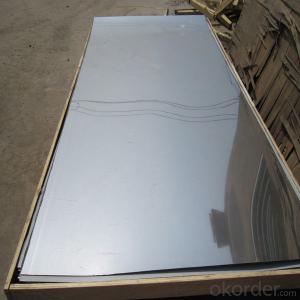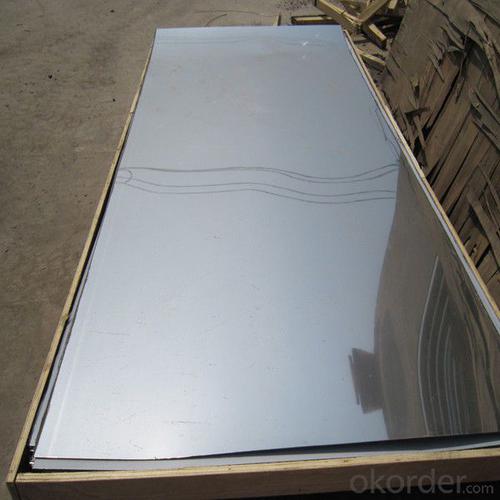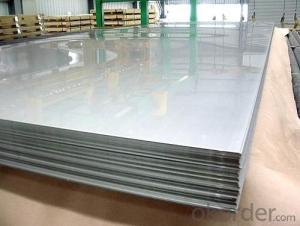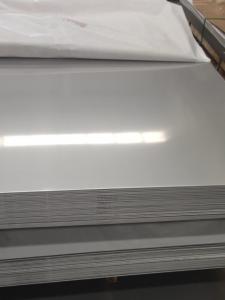Stainless Steel sheet 309S with No.4 Surface Treatment
- Loading Port:
- Shanghai
- Payment Terms:
- TT OR LC
- Min Order Qty:
- 500 m.t.
- Supply Capability:
- 5000000 m.t./month
OKorder Service Pledge
OKorder Financial Service
You Might Also Like
Hot sale stainless steel sheet 201/202/304/304l/310S/309S/316L/316Ti/316/321,410/420/430/444/443/409L, and 904L.
Description of Stainless Steel Sheet:
Description | steel sheet,hot rolled steel sheet,cold rolled steel sheet, steel sheet,sheet,steel plate |
Standard | ASME, ASTM, EN ,BS,GB,DIN, JIS etc |
Application | Steel sheet applies to construction field, ships building industry, petroleum & chemical industries, war and electricity industries, food processing and medical industry, boiler heat exchanger, machinery and hardware fields. |
Packaging | Standard export sea-worthy packing |
Delivery time | 10-30 days |
Quality | No.1 |
Productivity | 500 tons/Day |
Note | Our company has cooperative relation between the domestic agents. Stainless steel sheet can be made accordingto the customers requirements. Fasten delivery. Quality assured. |
Contacts | If you have any question,please feel free contact me. |
Stainless steel sheet surface finish characteristics
Surface finish | Characteristics and application |
2B | The surface brightness and flatness of no2B is better than no2D. then through a special surface treatment to improve its mechanical properties,No2B could nearly satisfy comprehensive uses. |
No.1 | Polished with abrasive belt of grit#100-#200, have better brightness with discontinuous coarse stria, used as inner and external ornaments for building, electrical appliances and kitchen utensils etc. |
No.4 | Polished with abrasive belt of grit #150-#180,have better brightness with discontinuous coarse stria, but thinner than No3, are used as bathtub buildings inner and external ornaments electrical appliances kitchen utensils and food processing equipment etc. |
HL | Polished with abrasive belt of grit #150-#320 on the NO.4 finish and has continuous streaks, mainly used as buildings ornaments elevators, door of building, frontal plate etc. |
BA | Cold rolled, bright annealed and skin-passed, the product have excellent brightness and good reflexivity like mirror, kitchen apparatus, ornament etc. |
8K | The product have excellent brightness and prefer reflexivity can to be the mirror. |
Main Features of stainless steel sheet :
•Escalator, Elevator, Doors
•Furniture
•Production tools, Kitchen appliances, freezers, cold rooms
•Auto Parts
•Machinery and Packaging
•Equipment and Medical devices
•Transport system
Product Details:
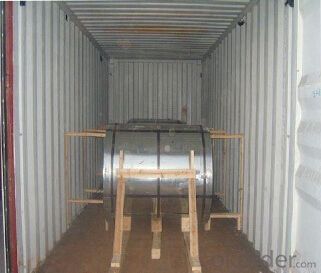


Sandard Seaworth Packing(wooden packing with water proof paper)


FAQ:
1. What's the quality?
very fine
2. How long get reply?
within 24 hours
If you have any question about stainless steel sheets,donot forget to sending the email to Us! You will get the competitive Price and have a very good experience about the Buying Process! CNBM International Corporation is always your trustful friend!
- Q: Are stainless steel sheets suitable for chemical processing equipment?
- Yes, stainless steel sheets are highly suitable for chemical processing equipment. Stainless steel is known for its exceptional corrosion resistance, making it resistant to chemical substances and environments. It is also durable, strong, and easy to clean, making it a preferred material for chemical processing equipment that requires regular exposure to various chemicals and rigorous cleaning procedures. Additionally, stainless steel has a high melting point, making it suitable for handling high temperatures often involved in chemical processes. Overall, stainless steel sheets are an excellent choice for chemical processing equipment due to their corrosion resistance, durability, strength, and ease of maintenance.
- Q: What are the different types of etched finishes available for stainless steel sheets?
- There are several different types of etched finishes available for stainless steel sheets, each providing a unique and distinctive appearance. Some of the most common etched finishes include: 1. Brushed Finish: This is a popular etched finish that creates a uniform and linear texture on the surface of the stainless steel sheet. It is achieved by brushing the sheet with a fine abrasive material, resulting in a smooth and satin-like appearance. 2. Bead Blasted Finish: In this etched finish, small glass or ceramic beads are blasted onto the surface of the stainless steel sheet at high pressure. This process creates a non-directional and uniform texture, giving the sheet a matte and slightly rough appearance. 3. Mirror Finish: Also known as a No. 8 finish, this etched finish creates a highly reflective and mirror-like surface on the stainless steel sheet. It is achieved through a series of grinding, buffing, and polishing processes, resulting in a flawless and shiny appearance. 4. Satin Finish: This etched finish is similar to a brushed finish but has a finer and smoother texture. It is achieved by using a finer abrasive material during the brushing process, resulting in a soft and elegant appearance. 5. Patterned Finish: This etched finish involves creating various patterns or designs on the surface of the stainless steel sheet. It can be achieved through techniques such as laser etching, chemical etching, or embossing, allowing for a wide range of creative and customizable options. These different etched finishes offer a variety of aesthetic choices for stainless steel sheets, allowing them to be used in various architectural, decorative, and industrial applications. The choice of finish depends on the desired appearance, functionality, and intended use of the stainless steel sheet.
- Q: What are the different types of stainless steel sheet finishes for marine applications?
- Marine applications commonly employ various types of stainless steel sheet finishes to enhance durability, corrosion resistance, and aesthetic appeal. 1. No. 1 Finish: Generally utilized for structural applications, this rough and non-reflective finish is achieved through hot-rolling. It offers good corrosion resistance and is suitable for marine applications where aesthetics are not a primary concern. 2. No. 2B Finish: Achieved through cold-rolling, annealing, and pickling, this smooth and reflective finish boasts excellent corrosion resistance. It is widely used in marine applications that require a moderate level of aesthetics. 3. No. 4 Finish: This brushed finish features a dull and non-reflective surface. It is obtained by grinding with progressively finer abrasives until the desired appearance is achieved. No. 4 finish is commonly chosen for marine applications where aesthetics play a crucial role, as it provides a clean and uniform look. 4. No. 8 Mirror Finish: Highly reflective, this finish is achieved by polishing with progressively finer abrasives until a mirror-like surface is obtained. No. 8 mirror finish is commonly utilized in marine applications where a high level of aesthetics is desired, as it offers a visually appealing and reflective surface. 5. Satin Finish: This semi-reflective finish is achieved by brushing the stainless steel sheet with a fine abrasive material. Satin finish is often selected for marine applications that require a moderate level of aesthetics, as it provides a clean and visually appealing surface. Apart from these standard finishes, specialized finishes like textured or patterned finishes are available for marine applications to enhance slip resistance. The choice of finish depends on specific requirements, including corrosion resistance, aesthetics, and functionality in the marine application.
- Q: What is the magnetic permeability of stainless steel sheets?
- The magnetic permeability of stainless steel sheets is typically very low, making them non-magnetic or only weakly magnetic.
- Q: What are the different types of stainless steel sheet surface coatings available?
- There are several different types of stainless steel sheet surface coatings available, each offering unique properties and benefits. Some of the most common types include: 1. No Coating: Stainless steel sheets without any coating have a natural, smooth surface finish. This type is often used in applications where corrosion resistance is a primary concern. 2. Brushed Finish: This coating creates a distinctive brushed pattern on the stainless steel surface. It provides a decorative appearance while also hiding scratches and fingerprints. 3. Mirror Finish: A mirror coating gives stainless steel sheets a highly reflective surface, similar to a mirror. This type is popular in architectural and decorative applications. 4. Satin Finish: Satin coatings offer a smooth, matte appearance with a low reflectivity. They are frequently used in high-end appliances and architectural elements. 5. Bead Blasted Finish: This coating creates a uniform, textured surface by bombarding the stainless steel with small glass beads. It provides a unique visual effect and can hide surface imperfections. 6. Patterned Finish: Patterned coatings involve embossing or etching designs onto the stainless steel surface. They can create a wide range of patterns and textures, adding aesthetic appeal to various applications. 7. Colored Coatings: Stainless steel sheets can be coated with various colors using processes such as powder coating or electroplating. This allows for customization and adds a decorative element to the material. It is important to consider the specific requirements of your application when selecting a stainless steel sheet surface coating. Factors such as corrosion resistance, durability, aesthetics, and functionality should all be taken into account to ensure the best choice for your needs.
- Q: Are stainless steel sheets suitable for water treatment applications?
- Yes, stainless steel sheets are highly suitable for water treatment applications. Stainless steel is known for its excellent corrosion resistance, making it the ideal choice for environments where water and moisture are present. It is resistant to rust, staining, and pitting, which ensures the longevity and durability of the sheets in water treatment facilities. Stainless steel sheets also offer hygienic properties, as they are easy to clean and maintain. This is crucial in water treatment applications where cleanliness and sanitation are of utmost importance. Additionally, stainless steel is non-reactive with water, meaning it does not leach harmful substances into the water being treated. Furthermore, stainless steel sheets are strong and can withstand high pressures and temperatures. This is critical in water treatment processes that involve filtration, disinfection, and other treatment methods that may require intense conditions. Overall, stainless steel sheets are an excellent choice for water treatment applications due to their corrosion resistance, hygienic properties, strength, and durability. They provide a reliable and long-lasting solution for various components in water treatment facilities, including tanks, pipes, valves, and other equipment.
- Q: Are stainless steel sheets suitable for marine propellers?
- Yes, stainless steel sheets are suitable for marine propellers. Stainless steel is a popular material choice for marine propellers due to its excellent corrosion resistance properties, which is essential in a marine environment where the propeller is constantly exposed to saltwater. The high strength and durability of stainless steel sheets also make them capable of withstanding the harsh conditions of the marine environment, including impacts and vibrations. Additionally, stainless steel has a low magnetic permeability, which helps reduce the formation of biofouling on the propeller, improving its performance and efficiency. Overall, stainless steel sheets are a suitable and widely used material for marine propellers.
- Q: Can stainless steel sheets be used for cryogenic applications?
- Indeed, cryogenic applications can utilize stainless steel sheets. Stainless steel boasts remarkable mechanical properties, corrosion resistance, and low thermal conductivity, rendering it fitting for cryogenic settings. It endures frigid temperatures without succumbing to brittleness or weakening. Frequently, stainless steel sheets find employment in cryogenic applications like storage tanks, piping systems, and cryogenic equipment. Nevertheless, it is crucial to select the proper grade of stainless steel, specifically intended for cryogenic applications, to guarantee utmost performance and durability.
- Q: Are stainless steel sheets resistant to acetic acid?
- Yes, stainless steel sheets are generally resistant to acetic acid. Acetic acid is a weak acid and does not cause significant corrosion or damage to stainless steel. However, prolonged exposure to highly concentrated or boiling acetic acid may cause some corrosion or staining on the surface of the stainless steel. It is important to note that the resistance of stainless steel to acetic acid can vary depending on the specific grade and composition of the stainless steel.
- Q: What is the electrical conductivity of stainless steel sheets?
- The electrical conductivity of stainless steel sheets is relatively low compared to other metals, such as copper or aluminum.
Send your message to us
Stainless Steel sheet 309S with No.4 Surface Treatment
- Loading Port:
- Shanghai
- Payment Terms:
- TT OR LC
- Min Order Qty:
- 500 m.t.
- Supply Capability:
- 5000000 m.t./month
OKorder Service Pledge
OKorder Financial Service
Similar products
Hot products
Hot Searches
Related keywords





